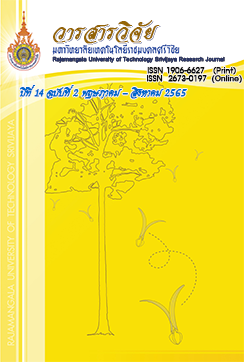Development of Decision-Making for Selection Splitter Distribution Points for the Optical Fiber Networks
Keywords:
Fiber Optic Network, Splitter Distribution Points, K-Nearest Neighbors, Neural Network, Support Vector MachineAbstract
The appropriate selection of the distribution point on the internet for the fiber-optic network (FTTx) is an important step that affects the efficiency of Internet service. The purposes of this research were to (1) develop a decision-making system for selecting the Splitter Distribution Points for fiber optic networks, (2) compare data classification methods, and (3) analyze the satisfaction evaluation results of system. The sample group consisted of 100 people, using a specific sample selection method. The research methods were web-based applications for deciding on the selection of the Splitter Distribution Points for fiber-optic networks through K-Nearest Neighbors: K-NN. The feature used consisted of Loss Bandwidth Package Dist and Class. The statistics applied in the study were means and standard deviations. The results of the research were as follows: the development of a decentralized decision-making system for fiber-optic networks made it an effective tool for selecting Splitter Distribution Points in the department. The research used K-Nearest Neighbors (K-NN) technique for decision-making in selecting Splitter Distribution Points model from three comparing methods of data segmentation, which were K-Nearest Neighbors (K-NN), Neural Network, and Support Vector Machine. The result of the experiment showed that K-Nearest Neighbors (K-NN) had the highest accuracy at 97.88%. The results of the system user satisfaction evaluation were divided into 3 areas: the operators’ satisfaction toward imported data was found at the highest level ( = 4.65, S.D. = 0.45); the workers' satisfaction toward the work processes of the system was perceived at the highest level ( = 4.68, S.D. = 0.51); and the satisfaction of the executives toward the results was observed at the highest level ( = 4.77, S.D. = 0.42).
References
Akdeniz, F. and Becerikli, Y. 2019. Performance Comparison of Support Vector Machine, K-Nearest-Neighbor, Artificial Neural Networks, and Recurrent Neural networks in Gender Recognition from Voice Signals, pp. 1-4. In 2019 3rd International Symposium on Multidisciplinary Studies and Innovative Technologies (ISMSIT). IEEE, Ankara, Turkey.
Ding, Z., Yang, D., Liu, K., Jiang, J., Du, Y., Li, B., Shang, M. and Liu, T. 2017. Long-Range OFDR-Based Distributed Vibration Optical Fiber Sensor by Multicharacteristics of Rayleigh Scattering. IEEE Photonics Journal 9(5): 1-11.
Ngernmoon, T., Moeikham, P. and Tippachon, W. 2017. Strawberry Ripeness Classification by Support Vector Machine. Naresuan University Engineering Journal 12(2): 55-62. (in Thai)
Royal Thai Government Gazette. 2018. National strategy announcement (A.D. 2018 - 2037). Royal Thai Government Gazette. Available Source: http://nscr.nesdb.go.th/wp-content/uploads/2019/10/National-Strategy-Eng-Final-25-OCT-2019.pdf, January 30, 2019.
Sasilawan, K. 2019. The Office of the National Broadcasting and Telecommunications Commission responded to the government's policy of sending 3-year free internet access to low-income households. Office of The National Broadcasting and Telecommunications Commission. Available Source: https://www.nbtc.go.th/Home.aspx?lang=en-us, January 30, 2019. (in Thai)
Songneam, N. 2020. Development of Waste Management Information System for One-stop Waste Management Learning Center. RMUTSV Research Journal 12(3): 506-521. (in Thai)
Sriurai, W. 2014. Patients Classification of Metabolic Syndrome Using Feature Selection and Artificial Neural Network. Srinakharinwirot Science Journal 30(1): 91-102. (in Thai)
Teerarassamee, P. 2015. The Methodology to Find Appropriate K for K-Nearest Neighbor Classification with Medical Datasets. Degree of Master of Engineering in Computer Engineering, Suranaree University of Techonology. (in Thai)
Thamsiri, D. and Meesad, P. 2011. Ensemble Data Classification Based on Decision Tree, Artificial Neuron Network and Support Vector Machine Optimized by Genetic Algorithm. The Journal of King Mongkut's University of Technology North Bangkok 21(2): 293-303. (in Thai)
TOT public company limited. 2017. Optical Fiber Termination Kit. tot public company limited. Available Source: https://www.tottcal.com/docs/PublicArticle/OFTK%20(Full%20article).pdf, January 30, 2019. (in Thai)
Vilailuck, S., Jaroenpuntaruk, V. and Wichadakul, D. 2015. Utilizing Data Mining Techniques to Forecast Student Academic Achievement of Kasetsart University Laboratory School Kamphaeng Saen Campus Educational Research and Development Center. Veridian E-Journal, Science and Technology Silpakorn University 2(2): 1-17. (in Thai)
Wang, Z. 2017. Dual-polarization two-port fiber-optic gyroscope. Springer Theses book series (Springer Theses), Singapore.
Downloads
Published
How to Cite
Issue
Section
License
Copyright (c) 2022 Rajamangala University of Technology Srivijaya Research Journal

This work is licensed under a Creative Commons Attribution-NonCommercial-NoDerivatives 4.0 International License.
The content and information in the article published in Journal of Rajamangala University of Technology Srivijaya It is the opinion and responsibility of the author of the article. The editorial journals do not need to agree. Or share any responsibility.







